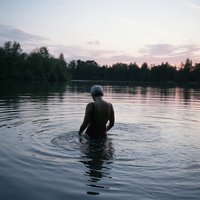Beata Szparagowska
After writing a thesis in literature on the powerlessness of words to say things, Beata Szparagowska came to Brussels and began studying photography at the Ecole Supérieure des Arts de l’Image “Le 75” (diploma in 2009). She has several individual and group exhibitions in Belgium, France and Switzerland to her credit, such as Studio Matonge (Namur, Brussels, Rencontres d'Arles 2010, Lille 2000), Cisza (Brussels), Hide & Seek (Brussels, Namur, Marseille, Paris, etc.), Lignes de fuite (Brussels, Photaumnales festival in Beauvais), Between Entre chien et loup (Brussels)…
Between 2010 and 2012, she was artist-in-residence at "L'L", a research and support center for young artists in Brussels, followed by the publication in 2012 of her first monographic book, Hide & Seek, published by Le caillou bleu. She develops documentary projects linked to different territories and communities. She often works with artists from the performing arts sector and is a member of the Ubik Group collective with whom she has co-written and staged several shows. For years, she has led photo workshops for diverse audiences. Recently, she began training in fascia therapy.
From one project to another, I seek forms of engagement with photographed reality that are of a different order from those of traditional reporting. Since the beginning of my practice as a professional, I have continued to reflect on the image, on its potential – on the one hand documentary, on the other fictional – and on its ambivalent nature. Working first and foremost in urban spaces occupied by the homeless, I wanted to be as wary of certain miserabilistic codes of "homeless photography" as I was of the dangers of aestheticization. In the streets, on the sidewalks, I was looking for traces. Just as I would later look for them in my native Poland, between re-recorded and reworked family photos and new photos of my childhood home, accessible for the last time on the eve of its being put up for sale. I'm always keen to question the image that is given, the image that we find, that we seek, that we take - or that we refuse to take. For the Studio Matonge series, refusing too obvious exoticism enabled me to set up a collaborative protocol of mise-en-scène and portraiture with the local inhabitants. I pursued a similar approach at the invitation of the City of Brussels to develop a project of posed portraits and in situ staging with teams of city sweepers. This project inspired the curators of the Triennale des arts d'Ottignies-Louvain-La-Neuve to commission me to create a series of staged images with local workers. My participatory projects have led me to discover other communities, other faces, other gestures to photograph. For several years I worked on a series of portraits with a group of young people from the Cureghem district of Brussels. This project culminated in a publication and an exhibition. In the same way, in the Melkriek district of Brussels, a project of on-site photo workshops gradually evolved into a more in-depth project on the inhabitants, living together and the changes taking place in the district.
Alternating with these more “documentary” projects (or in any case more anchored in the reality of the city), I develop series of photographed fictions. Started within L'L, a place of research for young creation in Brussels, the Hide & Seek series, distrusted the image of the show, the stage, the spots and the sets, to start again - in a centrifugal spiral and in complicity with the actors and dancers – from the research and rehearsal studio, to the backstage, then to the open air, to the landscapes outside the walls, sometimes a thousand kilometers from the starting focal point.
Then came another series, Open Space, developed with actors from the Ubik Group collective, with the aim of inventing and exploring dreamlike situations linked to the world of work. And recently, for the ongoing project Entre chien et loup, the idea is to make the landscape interact with the staging of the body in space, and from there to weave snippets of fiction imbued with the landscape, the light of dusk, the call of nature.
Between portraits and photos of lakes, meadows and forests, listen to this intimate link but also – again and again – stage it. Finally, as for projects more anchored in reality, I like to work on connections to be made with spectators: how can they receive these images, in what forms, how can a certain photographed experience be shareable, common? How can an image or a series of images become a breathing space, a place of freedom, of shareable dreams…
Website :
Language : French

